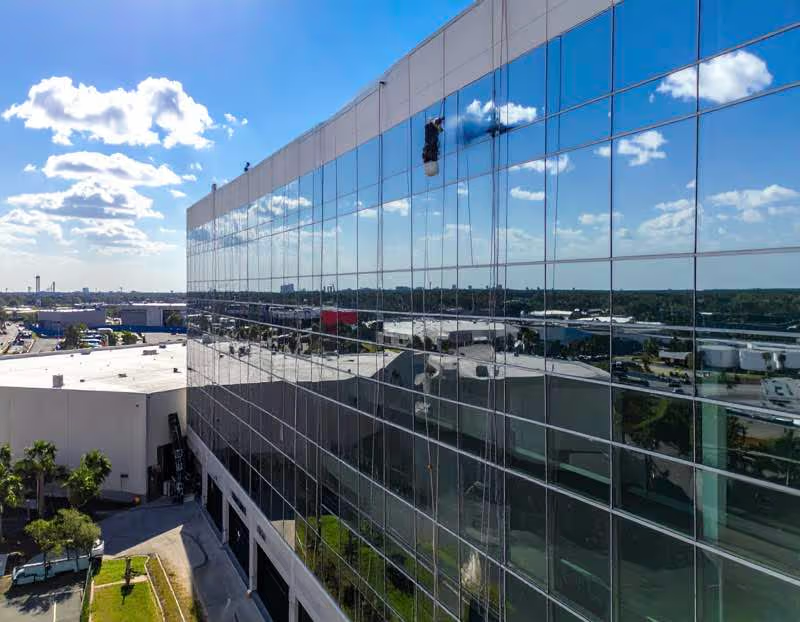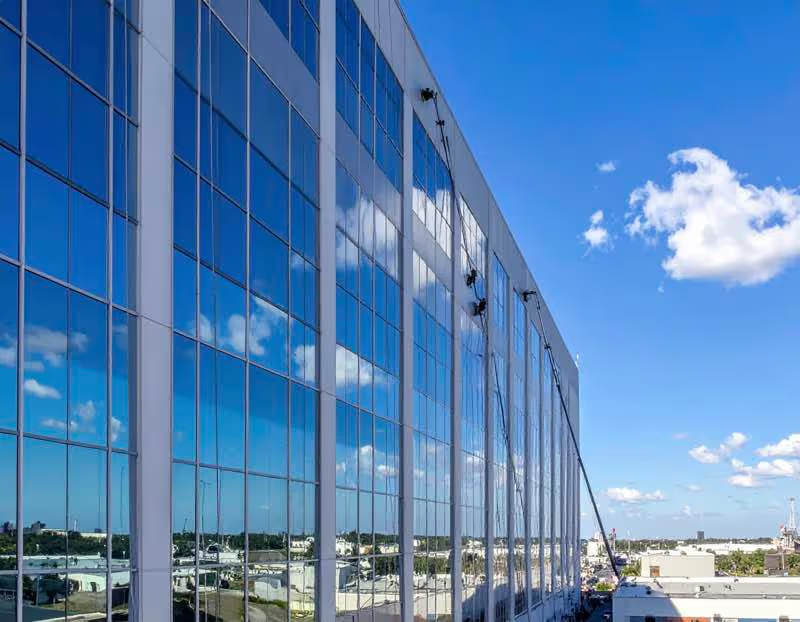
Industrial Window Cleaning Orlando: Clear Views for Warehouses, Factories & Commercial Facilities
Industrial window cleaning in Orlando removes the thick layers of dust, diesel exhaust, and manufacturing residue that accumulate on warehouse and factory windows, restoring natural light to work areas and improving safety for employees who need clear visibility.
Professional Window Cleaning Includes Full Exterior and Interior Surface Treatment
Industrial window cleaning addresses every glass surface in your facility, from ground-level office windows to high bay skylights thirty feet above the production floor. The process starts with exterior washing using commercial equipment and purified water systems that leave glass spotless without streaks or residue. Interior cleaning follows, covering office spaces, break rooms, and observation windows overlooking warehouse operations.
Comprehensive glass maintenance programs extend beyond the glass itself. Window frames collect mold and mildew in Orlando's humidity, creating dark stains that spread if left untreated. Sills trap pollen, dirt, and organic debris that hold moisture against the building envelope. Screens accumulate dust and spiderwebs that block airflow and reduce the effectiveness of your ventilation systems. Complete treatment addresses all these components, not just the visible glass.
I worked on a distribution facility in the Central Florida Research Park where years of neglect had created what looked like frosted glass on perfectly clear windows. The combination of hard water deposits, diesel film from nearby I-4 traffic, and algae growth from morning dew had built up a layer that blocked thirty percent of incoming light. After treatment, the operations manager told me his team could finally read part numbers clearly from across the warehouse floor. That visibility improvement translated directly into fewer picking errors and faster processing times.
Industrial facilities require different techniques than residential cleaning. Large glass panels need specialized equipment to reach safely and clean efficiently. Skylights and high bay windows demand boom lifts or scaffolding, not ladders propped against walls. Manufacturing environments with cleanroom requirements need contamination control measures that prevent particulate matter from entering sensitive areas during the cleaning process.
The difference between professional treatment and basic hosing shows most dramatically on vertical surfaces. Water alone pushes loose dirt around but leaves behind the bonded residue that causes actual visibility problems. Commercial cleaning solutions break down industrial grime—oil film from ventilation systems, exhaust deposits from forklifts, and the stubborn mineral buildup that Orlando's hard water creates on every outdoor surface.


Industrial Window Cleaning Requires Safety Equipment and Specialized Training
Working at height in industrial environments demands OSHA-compliant safety protocols that protect workers and facility operations. Professional window cleaners arrive with fall protection equipment, proper harnesses, and anchor point systems that meet federal workplace safety standards. This isn't about preventing falls—it's about having the right insurance coverage, training documentation, and equipment certifications when OSHA inspectors visit your facility during routine audits.
Orlando's industrial facilities range from single-story warehouses with accessible windows to multi-story manufacturing plants with glass thirty to fifty feet above grade. Each building type requires different equipment approaches. Boom lifts provide stable platforms for mid-rise facilities, while scaffolding works better for structures with complex roof lines or areas where motorized equipment can't safely operate. Some skylights require roof access with proper fall arrest systems and guardrails that protect workers from forty-foot drops to concrete floors below.
Training extends beyond equipment operation to understanding industrial environments. A cleaner working near production machinery needs awareness of pinch points, moving equipment, and designated pedestrian pathways. Manufacturing facilities with chemical processes require knowledge of emergency shutdown procedures and evacuation routes. Distribution centers with active loading docks demand constant vigilance around reversing trucks and forklift traffic.
I've cleaned windows at a pharmaceutical manufacturing plant in Lake Nona where the safety briefing took longer than the actual window cleaning. The facility had strict protocols about which areas were accessible during production runs, where we could stage equipment without blocking emergency exits, and how to communicate with floor supervisors before moving boom lifts near automated conveyor systems. That level of coordination protects both workers and your facility operations.
Florida's lightning risk adds another safety dimension during summer months. Central Florida leads the nation in cloud-to-ground lightning strikes, with afternoon thunderstorms rolling through Orlando almost daily from June through September. According to the National Safety Council, workplace safety protocols for severe weather including lightning require immediate work stoppage and proper shelter procedures to protect workers from environmental hazards. Professional window cleaners monitor weather radar and suspend outdoor work when storms approach, following the 30-30 rule: if thunder follows lightning by thirty seconds or less, take shelter and wait thirty minutes after the last lightning strike before resuming work.
Insurance requirements for industrial window cleaning differ substantially from residential service. Commercial general liability covers property damage and bodily injury, but industrial work requires higher coverage limits—typically one to two million dollars per occurrence. Workers compensation protects your facility from liability if a cleaning technician gets injured on your property. Professional window cleaning companies maintain these insurance policies and provide certificates of insurance immediately upon request, protecting your business from financial exposure.
Window Cleaning Timing Depends on Building Height and Weather Conditions
Scheduling industrial window cleaning around facility operations requires flexibility and understanding of production cycles. Many Orlando warehouses and manufacturing plants operate multiple shifts, making daytime cleaning disruptive to normal business flow. Weekend service works well for facilities that shut down production lines on Saturdays and Sundays. Night shift cleaning accommodates businesses with daytime operations that can't tolerate equipment or workers near production areas during peak hours.
Building height affects both service duration and equipment requirements. A single-story, 50,000-square-foot warehouse with standard eight-foot windows might take a crew four to six hours to complete thoroughly. Multi-story facilities require more complex logistics—setting up boom lifts, repositioning equipment between sections, and coordinating access to upper floors takes additional time. Manufacturing plants with mezzanine levels and skylights scattered across twenty-foot-high ceilings often need full-day service appointments to address all accessible glass surfaces.
Weather patterns in Central Florida influence both cleaning effectiveness and scheduling reliability. Orlando's dry season from November through April provides ideal conditions for window cleaning—minimal rain, lower humidity, and reduced pollen counts mean windows stay cleaner longer after professional service. Summer months bring daily afternoon thunderstorms that can interrupt outdoor work and wash away cleaning solutions before they've had time to break down stubborn deposits.
A facility manager I work with at an aerospace parts manufacturer near Orlando Executive Airport schedules all exterior window cleaning between December and March specifically because of weather reliability. During those months, we can plan service weeks in advance with confidence that weather won't force rescheduling. Summer appointments come with the understanding that we might need to return the following day if lightning storms cut the job short—a reality of working outdoors in Florida's subtropical climate.
Production schedules sometimes create narrow windows for maintenance work. Food processing facilities need cleaning completed between production runs when the facility undergoes thorough sanitation anyway. Pharmaceutical manufacturers require coordination with cleanroom protocols and air handling system operations. Distribution centers prefer service during slow periods between major shipping cycles when warehouse traffic is lighter and there's more room to position equipment safely. Corporate workspace glass maintenance follows similar coordination principles, working around business hours and employee schedules to minimize disruption.
Some facilities benefit from split scheduling—exterior cleaning during one visit, interior cleaning on a separate day. This approach minimizes disruption by allowing interior work during normal business hours when natural light comes through clean exterior glass, while saving equipment-intensive exterior cleaning for weekends or after-hours when parking lots are empty and there's no risk of water overspray landing on employee vehicles.
Clean Windows Improve Workplace Safety and Natural Light Quality
Dirty windows in industrial facilities create safety hazards that many property managers don't recognize until accidents occur. Forklift operators navigating narrow aisles near exterior windows rely on peripheral vision to spot pedestrians and other equipment. When dirt film blocks thirty to forty percent of incoming light, those sightlines diminish, increasing collision risk in high-traffic areas. Warehouse supervisors monitoring operations from elevated offices need clear glass to observe floor activities and respond quickly to safety concerns.
Natural light quality affects worker alertness and productivity throughout the day. Orlando facilities with clean windows bring in abundant Florida sunshine that reduces reliance on artificial lighting and creates more pleasant work environments. Studies in industrial settings consistently show that workers in naturally lit spaces report better focus, fewer headaches, and improved morale compared to employees in artificially lit warehouses. The difference becomes especially noticeable during long shifts when maintaining attention to detail matters most.
Security monitoring depends heavily on window clarity. Distribution centers with observation windows overlooking loading docks need clear sightlines to verify truck contents and monitor unauthorized access points. Manufacturing facilities with quality control stations positioned near windows require unobstructed views to inspect product details under natural light. Break room and office windows provide passive security by allowing workers to see parking lots and building perimeters, creating natural surveillance that deters theft and vandalism.
Energy efficiency improves when clean windows allow maximum light penetration. A facility running high bay lighting all day consumes substantially more electricity than one that can rely on natural light during daylight hours. While cleaning won't eliminate lighting needs entirely, it reduces the burden on your electrical system and lowers operating costs. This matters most in Orlando's summer months when air conditioning already drives utility bills to annual peaks.
I've worked with warehouse operations managers who schedule window cleaning before peak season specifically because of the safety improvements it brings. One distribution center in the Central Florida Innovation District handles twice the normal shipping volume from October through December during holiday season ramp-up. The operations director told me that cleaning windows in September gives his forklift drivers better visibility during the most demanding months of the year, when one collision could shut down operations and cost tens of thousands in damaged inventory.
The psychological impact of clean windows in industrial settings shouldn't be underestimated. Workers notice when management invests in facility appearance—it signals that leadership cares about working conditions and takes pride in the operation. That attention to environment affects employee satisfaction, which in turn influences retention rates and productivity. Manufacturing facilities competing for skilled technicians and warehouse workers in Orlando's tight labor market use facility appearance as a recruiting tool, and clean windows form part of that professional presentation.
Professional Window Cleaners Use Purified Water and Commercial-Grade Solutions
Industrial window cleaning relies on specialized equipment that produces results impossible to achieve with residential tools and techniques. Deionized water systems remove minerals from Orlando's notoriously hard water supply, creating pure H2O that cleans glass without leaving the white residue that standard tap water deposits on every surface it touches. This purified water acts as a solvent, breaking down dirt and pulling it away from glass without need for chemical additives that might leave streaks or residue.
Commercial-grade degreasers handle the industrial residue that accumulates on factory and warehouse windows. Manufacturing facilities near I-4 deal with diesel exhaust film that coats exterior glass with a greasy layer standard cleaners can't penetrate. Warehouses with natural gas-powered forklifts face similar buildup from exhaust particulates. Food processing plants accumulate oil vapor from fryers and cooking equipment that migrates to windows through ventilation systems. Each type of contamination requires specific cleaning solutions formulated to break down those particular compounds.
Hard water staining presents the most persistent challenge in Orlando. Our municipal water supply contains high concentrations of calcium and magnesium that bond to glass surfaces when water evaporates. Over months and years, these minerals create a cloudy film that makes windows appear frosted even after basic cleaning. Professional treatment uses acidic cleaning solutions specifically formulated to dissolve mineral deposits without damaging glass or surrounding materials.
Pressure washing equipment brings the mechanical force needed for heavily soiled surfaces. Industrial windows exposed to years of neglect often have layers of buildup that chemical cleaners alone can't remove. Controlled pressure application strips away accumulated grime while avoiding the damage that occurs when inexperienced operators use too much force. The difference between proper technique and amateur pressure washing shows most clearly on single-pane glass, which can shatter under excessive pressure, and on window seals, which deteriorate rapidly when water gets forced behind trim pieces.
Reach equipment extends service capabilities to high windows and skylights without expensive scaffold rental. Water-fed poles with brush heads deliver purified water and cleaning solution to glass twenty to forty feet above ground, allowing technicians to work safely from ground level instead of climbing ladders or operating lifts. This approach works especially well for routine maintenance cleaning where heavy buildup hasn't yet occurred.
Some industrial facilities require chemical-free cleaning methods that meet stringent contamination controls. Pharmaceutical manufacturing with classified cleanrooms can't risk chemical residues entering ventilation systems. Food processing facilities prohibit harsh cleaning agents near production areas. These specialized applications rely on mechanical cleaning with purified water, using abrasion and water flow to remove contaminants without introducing potentially harmful substances to sensitive environments.
The equipment investment required for professional industrial window cleaning runs tens of thousands of dollars—deionization systems, boom lifts, pressure washers, safety equipment, and vehicles capable of transporting all this gear between job sites. That capital requirement explains why attempting industrial window cleaning with residential equipment produces disappointing results. You're not just paying for labor when you hire professionals; you're accessing specialized tools that most facilities would never purchase for occasional use.
Frequently Asked Questions
How often should industrial windows be cleaned in Orlando?
Most industrial facilities schedule quarterly window cleaning to maintain consistent visibility and appearance. Facilities near I-4 or other major roads often need monthly service because diesel exhaust and road grime accumulate faster in high-traffic areas. Warehouses in less exposed locations might extend to twice-yearly cleaning if windows stay relatively clean between services. The right frequency depends on your building's exposure to traffic, your facility's visibility requirements, and how quickly dirt buildup affects operations.
Can you clean windows during business hours?
Yes, professional window cleaners work around your operational schedule including nights, weekends, and split shifts that minimize disruption to daily business. Interior cleaning typically happens during normal business hours when it's easiest to access office areas and coordinate with facility staff. Exterior cleaning using lifts and ladders often works better during off-hours when parking lots are empty and there's no concern about equipment blocking truck access or employee vehicles getting water overspray.
Do you clean interior factory windows and skylights?
Professional service addresses all accessible glass surfaces including high bay windows, mezzanine observation glass, and overhead skylights regardless of height. Skylights require specialized equipment—boom lifts for roof access or interior reach poles for facilities where roof access isn't practical. Some skylights can be cleaned from interior positions using water-fed poles, while others need exterior treatment from the roof surface. The approach depends on skylight design, building height, and roof accessibility.
Is window cleaning safe for coated or tinted industrial glass?
Professional techniques protect specialty glass installations through proper chemical selection and pressure control. Tinted windows get pH-neutral cleaning solutions that won't damage film adhesives or cause discoloration. Low-E coated glass requires gentle cleaning methods that preserve the microscopic coating responsible for energy efficiency benefits. Anti-glare glass and other specialty treatments need specific handling that trained technicians understand. Before service begins, we assess glass types and adjust methods accordingly to prevent any damage to expensive specialty installations.
How long does industrial window cleaning take in Orlando?
Service duration varies dramatically based on facility size and window accessibility. Small warehouses with easily accessible windows might take two to four hours for complete interior and exterior cleaning. Large distribution centers or multi-story manufacturing plants often require full-day appointments or multiple service days to address all glass surfaces thoroughly. Complex facilities with skylights, mezzanine windows, and high bay glass need more time for equipment setup, positioning, and safety protocols than straightforward single-story buildings.
Will you remove construction residue or paint overspray from new building windows?
Post-construction cleaning removes stickers, caulk residue, paint overspray, and other debris that contractors leave on new glass installations. This specialized service uses different techniques than standard maintenance cleaning—razor scraping for paint and adhesives, mineral spirit solutions for caulk removal, and careful edge work around fresh weatherstripping that hasn't fully cured yet. Construction residue cleaning typically takes longer and costs more than routine maintenance because of the stubborn nature of these contaminants and the precision required to remove them without damaging new materials.
Keep Your Orlando Industrial Facility Looking Professional
Your facility's appearance reflects directly on your business reputation. Clean windows signal professional management, attention to detail, and pride in operations. They improve safety, boost worker morale, and create the positive impression that clients and tenants expect when they visit your Orlando facility.
Pressure Washing Guys brings the equipment, training, and insurance coverage that industrial window cleaning demands. We work around your schedule, follow OSHA protocols, and deliver streak-free results that last. Serving warehouses, manufacturing facilities, and distribution centers throughout Orlando's industrial corridors.
Ready to restore clarity to your facility?
Call (407) 412-4015 or visit pressurewashingguysflorida.com
Licensed, insured, and equipped to handle facilities of any size across Orlando and Central Florida.


Get a quote within an hour for your project!
Our team responds fast so you can start your project
without delays or guesswork.

